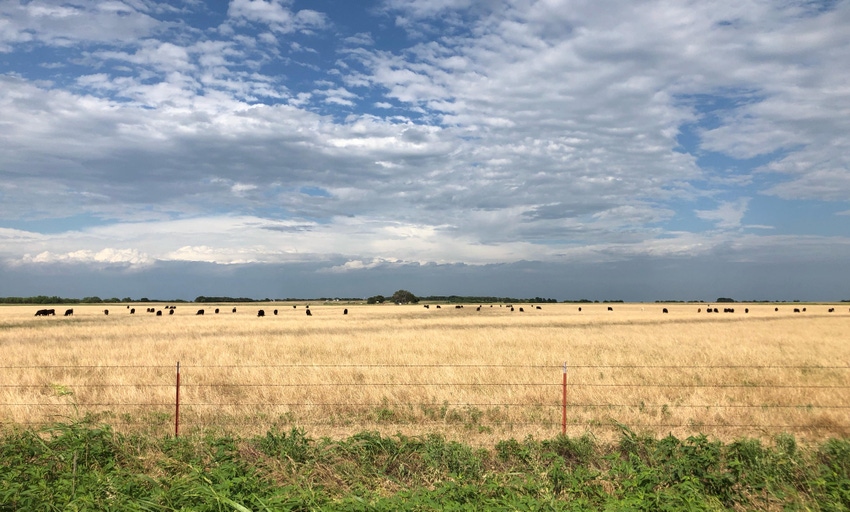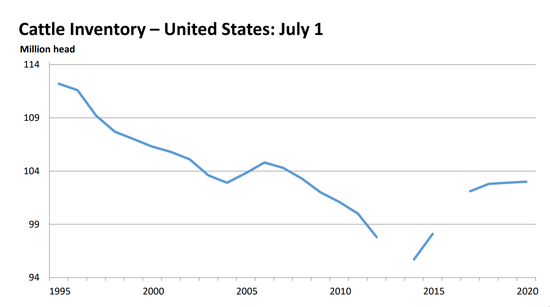Cattle on feed for over 120 days retracted slightly but still 19% ahead of same time last year.

The U.S. Department of Agriculture released two key cattle industry reports Friday, providing some insight into both the cow/calf and feedlot sectors.
The “Cattle on Feed” report showed that the U.S. feedlot inventory for feedlots with a capacity of 1,000 head or more totaled 11.4 million head on July 1, 2020, only slightly lower than July 1, 2019, but the second-highest July 1 inventory since the series began in 1996. The number was in line with the average pre-report estimate.
Analysts had expected placements to be 4% than the same time last year, but USDA reported total placements in feedlots during June of 1.80 million head, 2% above 2019. Net placements were 1.74 million head.
During June, placements were: 430,000 head for cattle and calves weighing less than 600 lb., 310,000 head for 600-699 lb. cattle and calves, 360,000 head for 700-799 lb. cattle and calves, 413,000 head for 800-899 lb. cattle and calves, 200,000 head for 900-999 lb. cattle and calves and 85,000 head for those weighing 1,000 lb. and greater.
According to the report, marketings of fed cattle during June totaled 1.97 million head, 1% above 2019 and in line with pre-report estimates.
The total feedlot inventory totaled 13.6 million head on July 1, 2020, unchanged from the July 1, 2019 Cattle on feed in feedlots with a capacity of 1,000 head or more accounted for 84% of total cattle on feed on July 1, 2020 -- down slightly from the previous year.
Oklahoma State University Extension livestock marketing specialist Derrell Peel said no major market reaction was expected following the report, and the industry had been looking for a couple of pieces of information from the latest report.
The first piece of information, he said, was an indication of the current status of feedlots relative to the backlog of fed cattle that developed in April and May.
“The calculated estimates of cattle on feed over 120 days is still very large compared to last year, but the difference has decreased by some 160,000 head since May. It appears that the backlog is decreasing, but a sizable number of cattle remain to be cleaned up before feedlots will be current,” Peel said.
In the January through April period, feedlot placements were down just over 1 million head year over year, he added.
In CME Group's “Daily Livestock Report,” Steiner Consulting Group said cattle on feed for more than 120 days retracted slightly from the 5.2 million head estimated last month to 4.9 million head, which is still 19% ahead of last year. “Front-end supplies will need to see slaughter above a year ago to work through those volumes,” the group noted.
Meanwhile, the report also may also indicate some regional drought effects, Peel said.
“June placements were large year over year in both Texas and Colorado, and both states showed an increase in placements under 700 lb. In fact, the 8.8% year-over-year increase in placements under 700 lb. in the report is entirely accounted for by increased lightweight placements in Texas and Colorado,” he said.
No dramatic changes in cattle inventory
USDA’s July “Cattle” report provided a midyear update on cattle inventories as well as the 2020 calf crop. Peel said the report did not show any dramatic changes in the overall trajectory of the cattle industry at this point in the year. However, he did note that interpretation of the numbers is a bit challenging, given the continuing backlog of fed cattle that must be accounted for in the numbers.
“The overall cattle and calves inventory was fractionally up from last year but likely would have been down slightly in the absence of the feedlot backlog,” he said.
According to the report, all cattle and calves in the U.S. on July 1, 2020, totaled 103 million head.

Both the beef cow and calf crop numbers were down less than 1% year over year. Beef replacement heifers numbers were even with year earlier totals. The inventory of beef cows and replacement heifers totaled 32.05 million head and 4.4 million head, respectively.
USDA is currently estimating the 2020 calf crop at 35.8 million head. Using the various feeder inventory estimates, Peel calculated the feeder cattle supply at 37.4 million head, up 0.8% year over year.
According to Peel, the trade was anticipating the report because it was expected to show whether the industry is liquidating in the aftermath of the turmoil and market shocks of recent months.
“The slow decrease in beef cow numbers is consistent with the January pace and, combined with stable replacement heifer numbers, does not indicate any accelerated liquidation at this point,” he said, adding that the second half of the year may tell the real tale as cow/calf producers react to fall calf market conditions. “Overall, it appears that cattle numbers continue a slow tightening of inventories going forward,” Peel said.
About the Author(s)
You May Also Like





